This article is written by my son “The Rabbit Shepherd” of whom I am so proud!
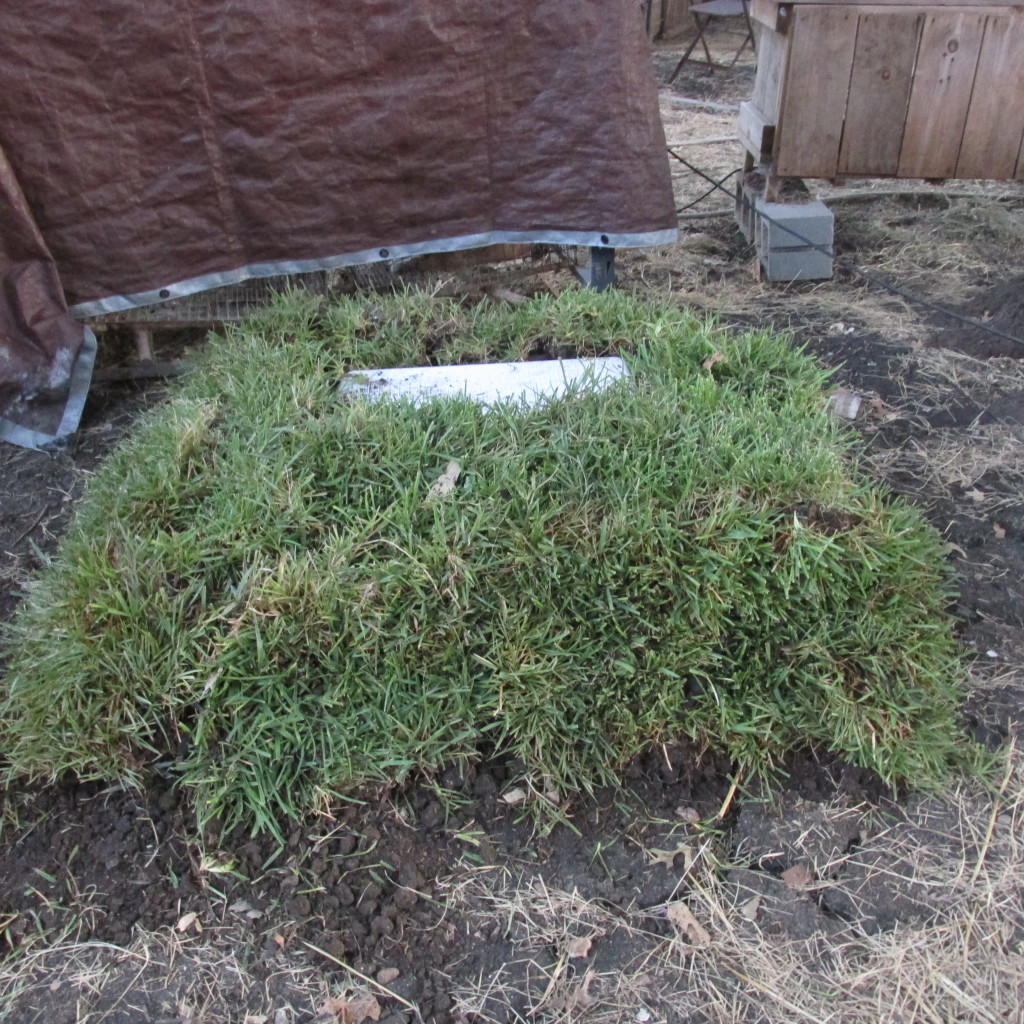
Everyone, who breeds rabbits in the south, knows that in the hot summer months your rabbits are not able to breed and be productive. I want to be a missionary in Africa when I am older. I wanted to see if a rabbit would be able to breed better and would be healthier overall in a hot dry climate, if it had an underground den to nest in. If my plan works, it could be a valuable source of meat or income for a family in Africa. Africa is a big continent so I am comparing the weather in Kenya, because the temperatures and rainfall are very similar to Texas. I am learning a lot, however I have had a few set backs. I am interested to know how it will turn out.
My hypothesis: that a rabbit will be able to breed through the summer and will be healthier over all.
Also I believe that more babies will be born and survive in the under ground den than in the outside cage with out a den. At the present time I am taking temperature readings to see if the den is warmer in the winter in comparison with the outside temperature.
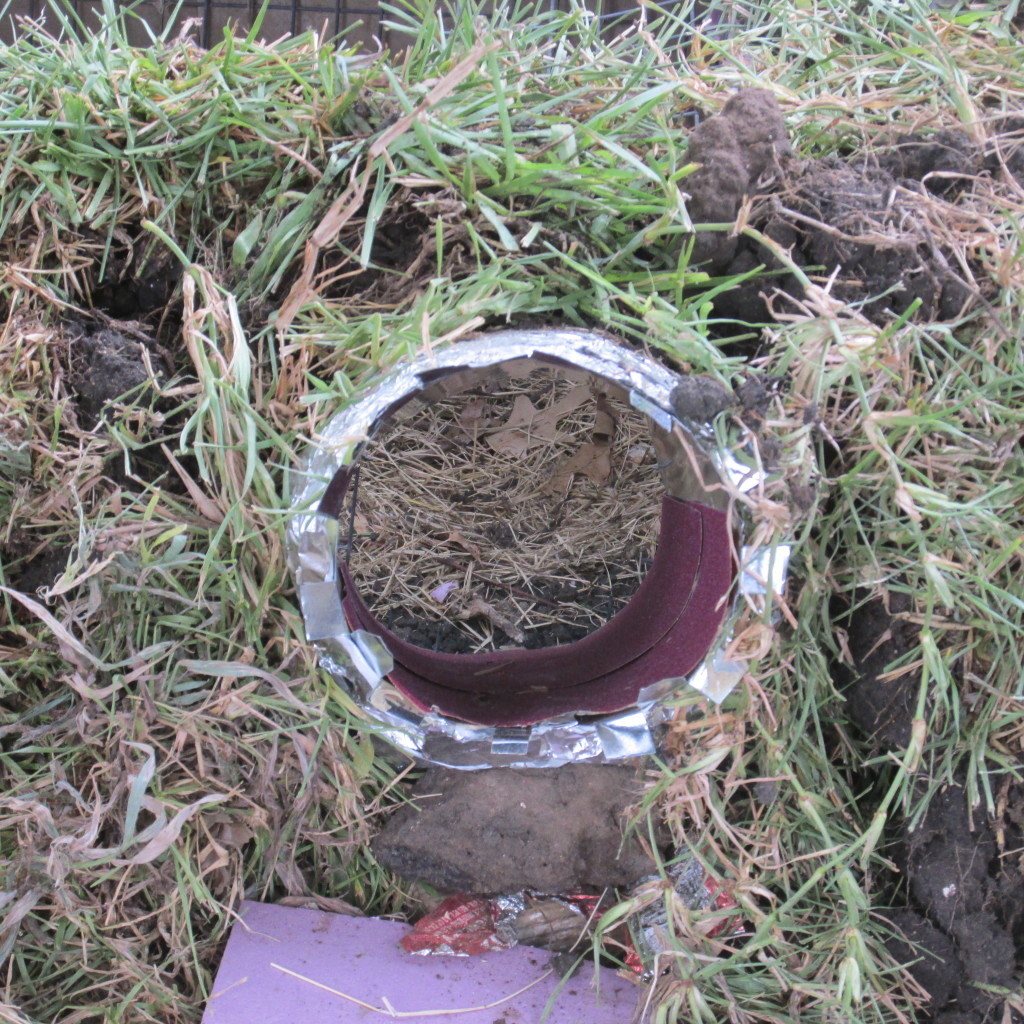
The underground den has a tunnel that leads to a cage where the rabbit gets it’s food and hopefully poops, leaving the den for nesting. I thought that the rabbit would poop in the den, but was surprised to find that it comes out into the above ground part of the cage to do it’s business. All the poop drops down into a tray that I have to change WAY to often for my liking. Anyway, this is the way I built my underground den.
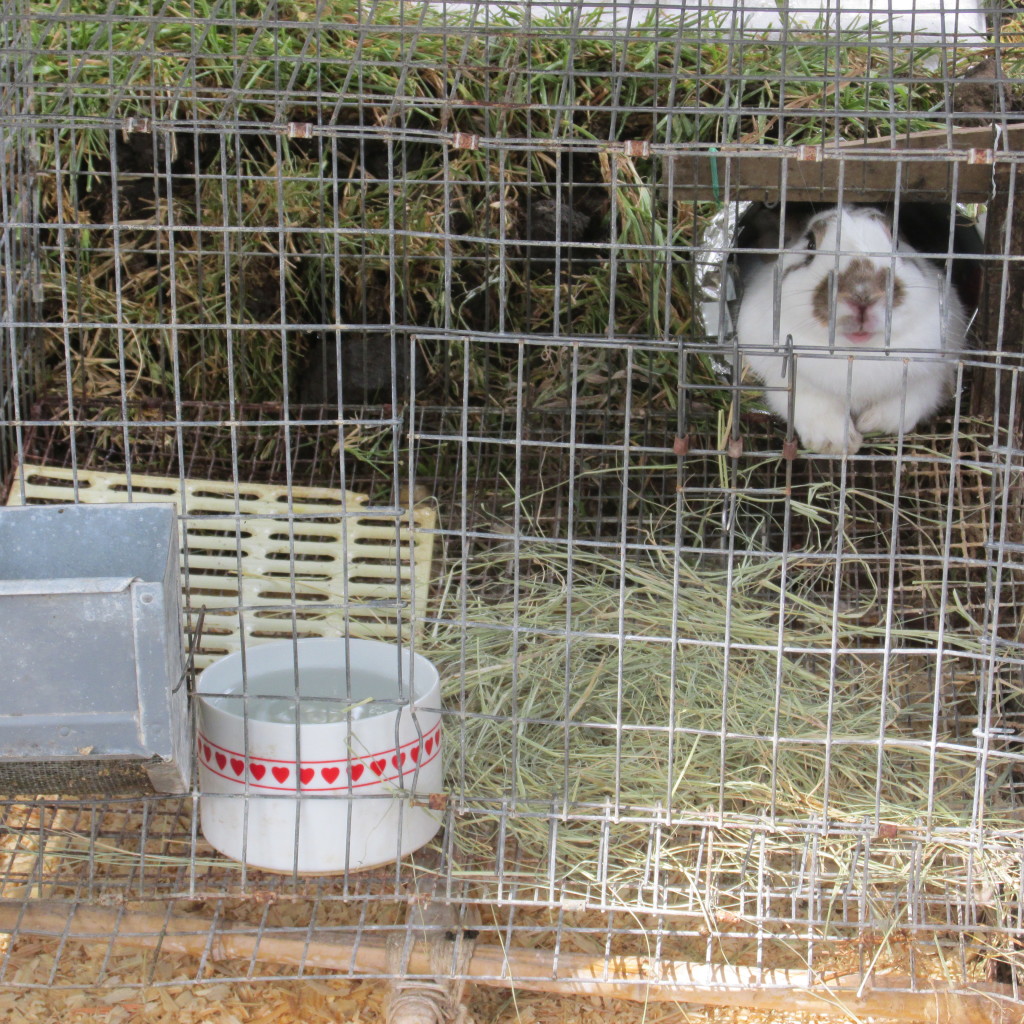
Materials:
wire cage, ceramic tile, cement cinder blocks, metal pipe, insulation wrapping, metal duct tape, sod or soil, sandpaper
Tools needed:
shovel or digging tools, wire cutters, a wet saw to cut the ceramic tile,
Construction of the underground rabbit den.
Step 1: Starting with a wire rabbit cage that was 24″x 20″ x 16″ the first step was to dig a hole a little bigger than the cage. Because of tree roots the cage could not be buried fully into the ground.
It ended up being just 6″ into the ground, which ended up being a good thing because flooding was a problem. Save the extra dirt for the next step.
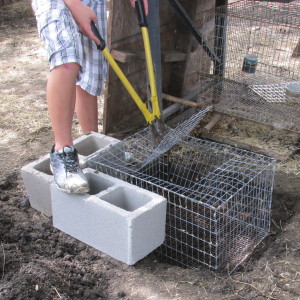
Step 2: Cut out the top of the cage. The hole needs to be just big enough to get the rabbit out of. A lid from an old ice chest surrounded by Styrofoam board made a tight fit.
Step 3: Surrounding the cage with ceramic tile kept the dirt from falling into the den. Some of the tile had to be cut with a wet saw to fit around the cage. Cement Cinder blocks were placed around the cage resting on the ground. Packing them with dirt gave the den needed insulation.
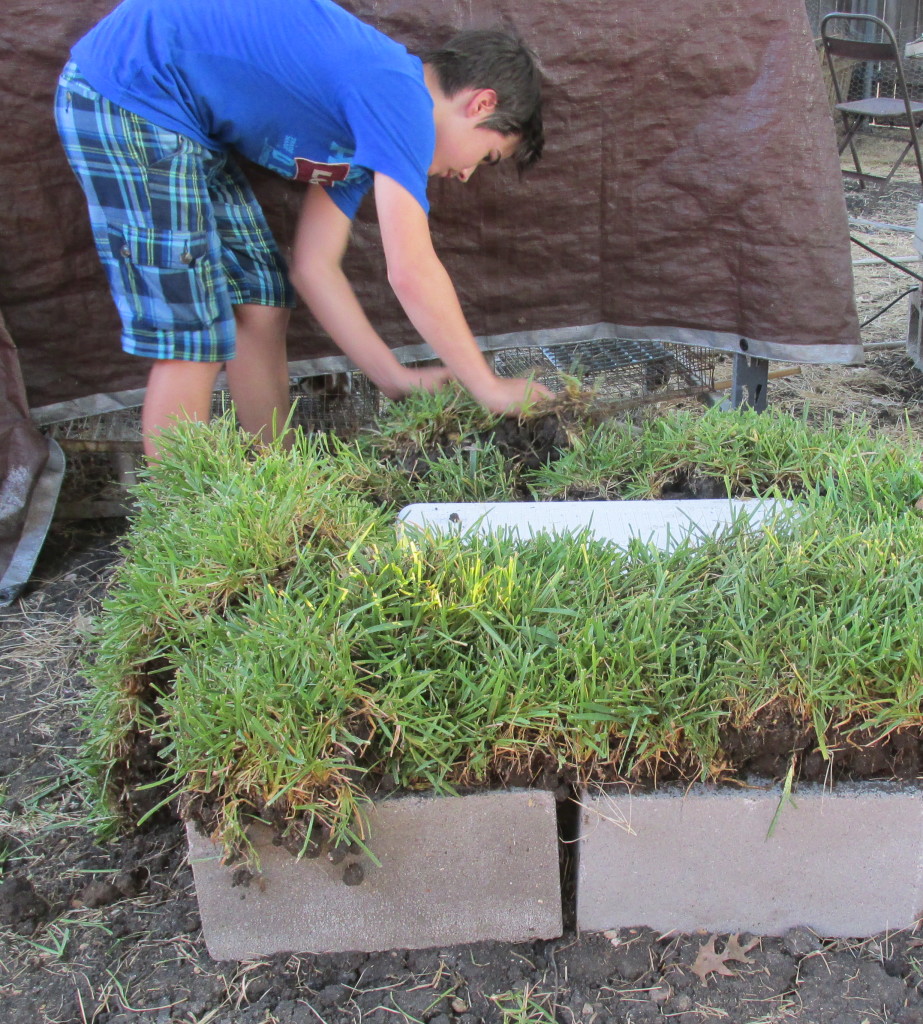
The last step was to cover the den with sod and stomp it down positioning the cooler lid on top of the opening with a heavy brick on top to keep predators out.
I got a metal tube and put insulation with metal tape all over the outside. Sand paper created traction so that the rabbit could climb up the tunnel and into the above ground cage.
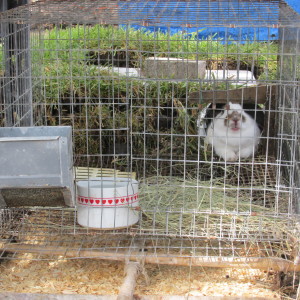
The rabbit gets food and water in the above ground cage. It is just a wire cage set up so the rabbit can go back and forth when it wants.
I am excited to see if this experiment will enable us to breed rabbits even in the heat of Summer when the rabbit would normally go temporarily sterile.


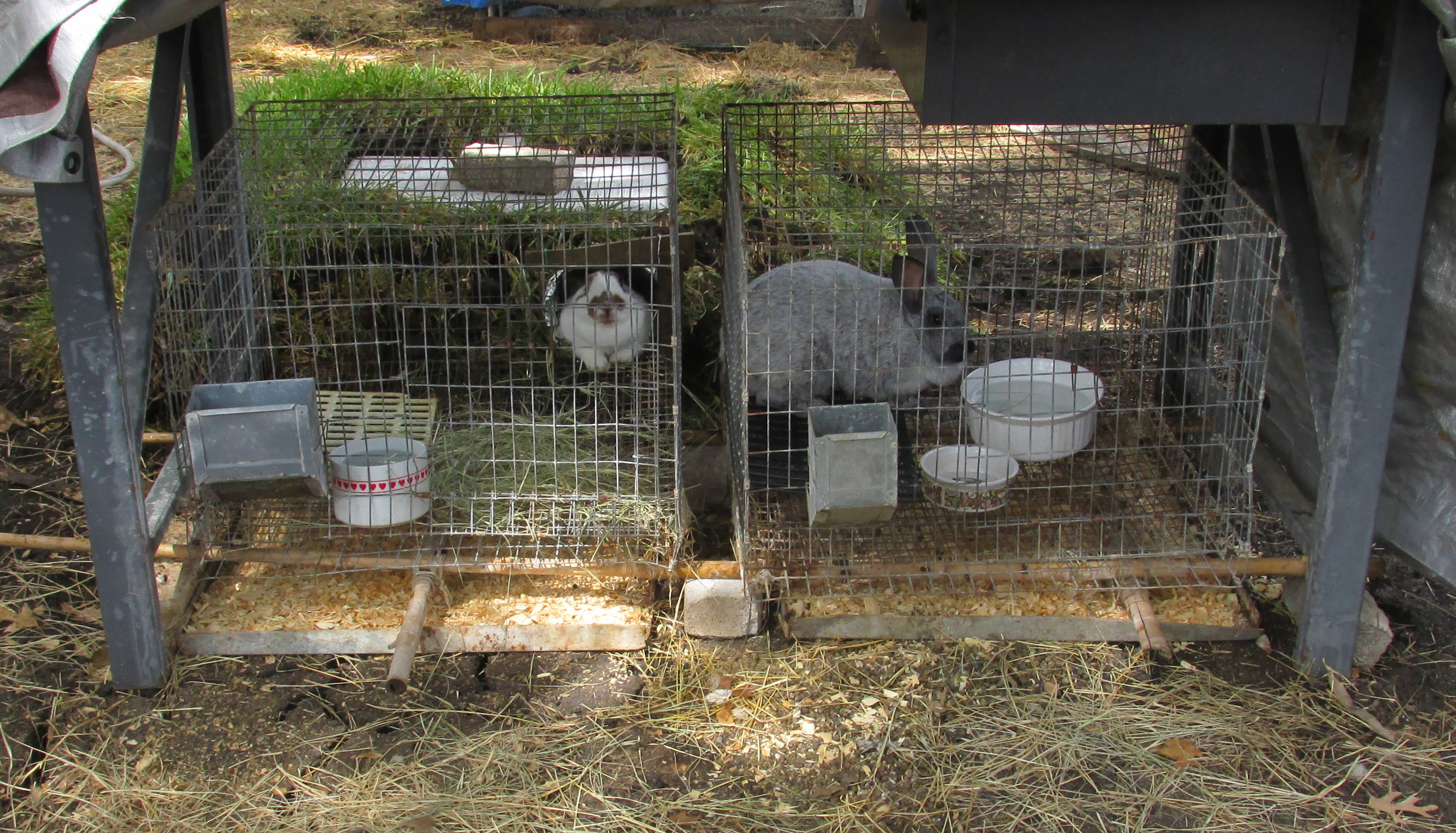

Dear Dash,
Have you tried to grow red worms under the rabbit cage to help with the rabbit poop? I experimented with the combination of rabbits, chickens and worms . The rabbits were in wire cage, the worms were in concrete block container under the rabbits and the chickens “run” was where they could scratch and run under the rabbit cages part of the day. It worked for us fairly well, it helped to keep down smell, and work of mucking out from under the rabbits was cut down because of the worms digested the rabbit poop and the chickens ate the rabbit food that dropped through the cage on to the ground and the chickens liked to scratch around in the hay that fell from the rabbit cage. I don’t know if this will work in your situation, but I offer it just in case it might help. We were living in Florida at the time and dealing with heat and humidity as well as predictors.
Thanks Dolly, I have been thinking about trying worms under the rabbits. Right now I rake up the rabbit pellets to put on the garden. It is a lot of work though raking, scooping and carting to the garden. Good idea to cut down on the work. We are trying a new rabbit den with hay bales this year. Interested to see how it works.
I don’t suppose you used any thermometers to tell what the temperature difference was outside vs. in den? Also I don’t think I read if summer breeding was successful. I plan to a similar project in Southern California high desert wher summer temps are at or near 100 degrees for about three months. Interested in your work bud!
Hi Alvin, Good to know others are working on this. Would love to see your results. To answer your question. Yes we took temperature readings, although it wasn’t easy, because the rabbit kept attacking/chewing our probe! I am making a wire encasing for it this time. We started the experiment in the Winter and then noticed the flooding. So while the temps in Winter were a bit warmer in the den we never got summer temps. I was working on building new dens last week end so almost ready to start again! I will be sure to put the temp readings on the post this time. Good luck with yours. Send me pictures if you can.
Pity you can’t spend your time ensuring rabbits are happy and healthy and enjoying their lives as they have a right to do not just used as a means to line your pockets. I intend to keep rabbits in my garden in a way that will ensure they enjoy their life on this earth – your time would be better spent with some gainful employment and not exploiting a beautiful creature. If you can’t enhance a creatures life then for god’s sake leave it alone. I am sure it would be better off not knowing you!
Hi M, I am confused by your comment. My 12 yr old son did a wonderful experiment of building a rabbit den to improve the lives of people that might need a food source in Africa. I know when you don’t live with the problem of food scarcity it is hard to imagine the feeling of an empty stomach growling at you most of the day or the feeling of a parent who has nothing to offer their child. I am very proud of him being able to think through these mature concepts that affect people and take action on a way to solve the problem, while still offering the hungry family the dignity of being able to provide for themselves.
“If you give a man a fish you feed him for a day. If you teach a man to fish you feed him for a lifetime.”
I do think it is important to give the best life for the animal that is possible. Rabbits feel most comfortable in a den situation so that they can escape predators. My son’s rabbits also get out in exercise pens , but a cage is needed for protection at night. My son wrote that article and I think he did a fine job. It amazes me that after living in The Land of Abundance he can have compassion for other human beings. I am so proud of him!
Hello,
Congratulations on your great site! I am really glad to have found it and feel like I’ve met a precious kindred spirit.
We are an urban homesteading family of 6 who just started raising rabbits this year and have been really worried by how hard the summer heat seems to be on our animals. This year July has been running in the 90s all the time, and even with shade cloth, ice packs to rest on, and frequent trips to put ice in the water, I am constantly fretting over them and it certainly does not seem like a good way forward for the years to come. I really like the idea of an underground shelter. It is low-tech and reliable, even at temperatures more extreme than what our climate usually delivers, from what I’ve read. What I wanted to ask is how the setup did during the rainy season? We have clay soil and were concerned about the burrow flooding after a good rain. I would assume that the rabbits would just avoid the burrow in that case and live in the above-ground part of their run (we would put the underground burrow inside their 50 square foot run), but would love to have your input as somebody who has already experimented with this.
Kind regards,
McKinley
Hi McKinley, Thank you for your kind encouragement. I should do an update to that post because the den did flood. We tried and tried but we couldn’t avoid the flood!
We have our rabbits in cages now. We got up to 113 this Summer and they did good with ice packs(frozen water bottles)
However we are building a colony type set up and will try the underground den again. This time I think we will try tubes going into buried 5 gallon buckets with holes cut in the sides. I will capture it on video when we do it. I hope it will work! Our goal is to use the colony space for grow outs part of the time and for the breeders in the Summer. We are halfway through, but it is too hot to build just now! Sorry it took me so long to answer. We have been busy doing a rabbit raising course.
Blessings on your homestead, Dash
How bad was the flooding? I want to build an underground den for my bunnies that they can go into to escape some heat – I live in miami and I also use frozen water bottles and ice water but don’t always feel that is enough. After reading your post – I was thinking maybe I would dig a hole bug enough to sink an actual cooler (plastic kind not styrofoam since I’m afraid the bunnies will dig and chew on the foam kind) so that the sides of the den are water tight – I’ll leave the lid open like you did so I can open the den up to put ice in there too each day so they can go in there and it won’t melt so fast, it’ll stay cool like a refrigerator during the day after I close the lid, hopefully. Somehow Ill have to make a hole in the side and make a tunnel out. What do you think? Any ideas for the hole to get out?
Hi Marianne, I think that is a great idea. We thought about doing that very thing. I think air pipe vents might work for a tunnel in with a aquarium sealer around it to make it water tight? Cutting the hole might be a bit hard. Electric saws all?
I saw a post where someone used a 5 gallon bucket with a hole cut in the side. They buried it part way so they could take the lid off and check. They used big pvc for the tunnel. Please let me know if you try the cooler. I think it will work! Good luck keeping those bunnies cool. We have to all think outside the box! Right? Blessings, Dash
Hello again,
I just wanted to write back to say that in the end, the rabbits have done all of the work for me. In a very short period of time, they dug up against (but thankfully not under and out of) the sunk concrete rim around their run, down to about a foot. They created their own little hollowed out place and were so comfortable there that they hardly needed ice packs on the hottest day of the year, when it was 100°. And these are angora rabbits! (albeit shorn down to one inch). Their run is open to the elements, so I’ll have to see what their little pit does when it gets rainy, but in the interim, I’m really grateful for their hard work. It has given me tremendous peace of mind to know that they are cool, comfortable, and safe.
Best wishes,
McKinley
Wow, I am so glad you were successful in keeping them cool! Thank you for writing back and sharing this victory. It is very encouraging! I will start working on mine in the Fall when it gets a little cooler. I’ll let you know how it goes. Blessings Dash
Hello I too am working on building underground dens. I live in central FL and know males and females have great difficulty breeding in the hot summers here. I have elected to do My dens out of concrete. I didn’t dig down at all. I am actually digging a garden bed at the same time so im moving that sand on top of the hutches. I have almost finished one of them. I am lining them up together. Inside they will be about 2.5 feet wide and tall with a 1.5 foot tube that will also be buried going to the outside pen. I will be digging below the pen about 3 feet to allow space for chickens to run around and stir things up. I will be surrounding them with chain link fencing so I can grow climbing vegetables on it for shade. Their hutches will also have vegetation on top as well. I have started skiing YouTube videos to document as i see this is a fairly new concept. If you would like to follow along its under orlando permaculture project. Its in the very beginning stages though. I’m very driven and it will be moving fast though! I would be working now at it but unfortunately I need to rest from being sick.
So cool! I will look you up and follow along. We have given up on our project for now because we couldn’t overcome flooding, but always have it in our minds to find a way to breed in the heat! I saw someone put their hutch under a water tank to keep it cool. So excited to see what you come up with! Thank you! Dash
I am working on building the burrow above ground using cinder blocks wrapped in insulation and dirt mounted over it. Will be using blocks to keep it off the ground. 1. Because of flooding and 2. Our ground is hard as concrete here in central west Texas. Will do temperature checks before putting rabbits in it. We had temps of 110 last week.
I am so excited to hear this! We gave up on our den experiment after an outbreak of coccidiosis. It was pretty brutal on us. We had to put babies down that were screaming in pain! It was heartbreaking. So now we have everyone in cages, but have ground pens they can play in when conditions are not favorable for coccidiosis. Everyone has done well, but we cannot breed during the summer months. So we wait till the weather cools off to breed. Oh I would love to see your results. Are you sharing it somewhere? You should youtube it! So glad you are doing this. I think it is valuable as our weather gets crazy hot, but also for other countries that don’t have the luxury of air conditioning.
Best of luck, Dash